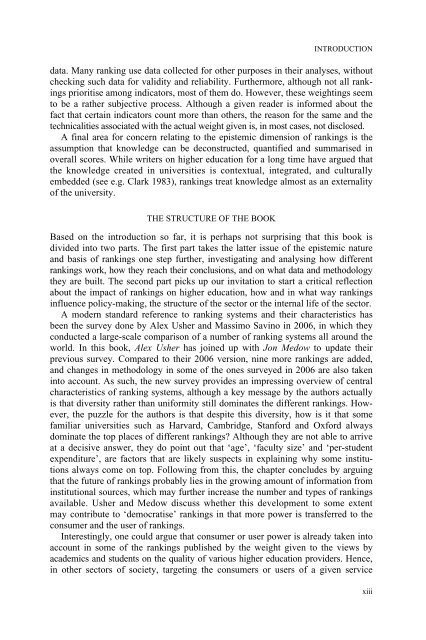University Rankings, Diversity, and the New ... - Sense Publishers
University Rankings, Diversity, and the New ... - Sense Publishers
University Rankings, Diversity, and the New ... - Sense Publishers
Create successful ePaper yourself
Turn your PDF publications into a flip-book with our unique Google optimized e-Paper software.
INTRODUCTION<br />
data. Many ranking use data collected for o<strong>the</strong>r purposes in <strong>the</strong>ir analyses, without<br />
checking such data for validity <strong>and</strong> reliability. Fur<strong>the</strong>rmore, although not all rankings<br />
prioritise among indicators, most of <strong>the</strong>m do. However, <strong>the</strong>se weightings seem<br />
to be a ra<strong>the</strong>r subjective process. Although a given reader is informed about <strong>the</strong><br />
fact that certain indicators count more than o<strong>the</strong>rs, <strong>the</strong> reason for <strong>the</strong> same <strong>and</strong> <strong>the</strong><br />
technicalities associated with <strong>the</strong> actual weight given is, in most cases, not disclosed.<br />
A final area for concern relating to <strong>the</strong> epistemic dimension of rankings is <strong>the</strong><br />
assumption that knowledge can be deconstructed, quantified <strong>and</strong> summarised in<br />
overall scores. While writers on higher education for a long time have argued that<br />
<strong>the</strong> knowledge created in universities is contextual, integrated, <strong>and</strong> culturally<br />
embedded (see e.g. Clark 1983), rankings treat knowledge almost as an externality<br />
of <strong>the</strong> university.<br />
THE STRUCTURE OF THE BOOK<br />
Based on <strong>the</strong> introduction so far, it is perhaps not surprising that this book is<br />
divided into two parts. The first part takes <strong>the</strong> latter issue of <strong>the</strong> epistemic nature<br />
<strong>and</strong> basis of rankings one step fur<strong>the</strong>r, investigating <strong>and</strong> analysing how different<br />
rankings work, how <strong>the</strong>y reach <strong>the</strong>ir conclusions, <strong>and</strong> on what data <strong>and</strong> methodology<br />
<strong>the</strong>y are built. The second part picks up our invitation to start a critical reflection<br />
about <strong>the</strong> impact of rankings on higher education, how <strong>and</strong> in what way rankings<br />
influence policy-making, <strong>the</strong> structure of <strong>the</strong> sector or <strong>the</strong> internal life of <strong>the</strong> sector.<br />
A modern st<strong>and</strong>ard reference to ranking systems <strong>and</strong> <strong>the</strong>ir characteristics has<br />
been <strong>the</strong> survey done by Alex Usher <strong>and</strong> Massimo Savino in 2006, in which <strong>the</strong>y<br />
conducted a large-scale comparison of a number of ranking systems all around <strong>the</strong><br />
world. In this book, Alex Usher has joined up with Jon Medow to update <strong>the</strong>ir<br />
previous survey. Compared to <strong>the</strong>ir 2006 version, nine more rankings are added,<br />
<strong>and</strong> changes in methodology in some of <strong>the</strong> ones surveyed in 2006 are also taken<br />
into account. As such, <strong>the</strong> new survey provides an impressing overview of central<br />
characteristics of ranking systems, although a key message by <strong>the</strong> authors actually<br />
is that diversity ra<strong>the</strong>r than uniformity still dominates <strong>the</strong> different rankings. However,<br />
<strong>the</strong> puzzle for <strong>the</strong> authors is that despite this diversity, how is it that some<br />
familiar universities such as Harvard, Cambridge, Stanford <strong>and</strong> Oxford always<br />
dominate <strong>the</strong> top places of different rankings? Although <strong>the</strong>y are not able to arrive<br />
at a decisive answer, <strong>the</strong>y do point out that ‘age’, ‘faculty size’ <strong>and</strong> ‘per-student<br />
expenditure’, are factors that are likely suspects in explaining why some institutions<br />
always come on top. Following from this, <strong>the</strong> chapter concludes by arguing<br />
that <strong>the</strong> future of rankings probably lies in <strong>the</strong> growing amount of information from<br />
institutional sources, which may fur<strong>the</strong>r increase <strong>the</strong> number <strong>and</strong> types of rankings<br />
available. Usher <strong>and</strong> Medow discuss whe<strong>the</strong>r this development to some extent<br />
may contribute to ‘democratise’ rankings in that more power is transferred to <strong>the</strong><br />
consumer <strong>and</strong> <strong>the</strong> user of rankings.<br />
Interestingly, one could argue that consumer or user power is already taken into<br />
account in some of <strong>the</strong> rankings published by <strong>the</strong> weight given to <strong>the</strong> views by<br />
academics <strong>and</strong> students on <strong>the</strong> quality of various higher education providers. Hence,<br />
in o<strong>the</strong>r sectors of society, targeting <strong>the</strong> consumers or users of a given service<br />
xiii














